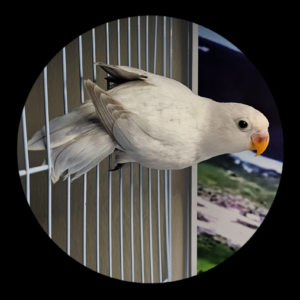agapornis dilute mutations
The dilute mutations in the Agapornis species (including species such as the Fischer’s Lovebird and Peach-faced Lovebird) are fascinating genetic variations on pigmentation found in such cute parrots. Such mutations cause changes with respect to their coloring and easily distinguish them from their wild type siblings. This thorough guide will take a closer look at the category of dilute mutations among Agapornis lovebirds species; the types they come in, as well as their genetic composition and effect on these cute feathered friends that are loved by many people.

Understanding Dilute Mutations:
A mutation is a change in the concentration of a gene resulting in reduced intensity of the pigment responsible for feather coloration. The various mutations arise mostly by interfering with the light and dark (melanin) pigmentation. This eventually results into different light and pale colored shades of the plume. Mutations can be diluted to different levels in various species and even within the same subtype.
Types of Dilute Mutations:
Green Dilute:
A color abnormality called “Green Dilute” is seen among Fischer’s Lovebirds, and it alters the natural green plumage of the wild type lovebirds. The mutation of Wild Fischer’s lovebird is the Green Dilute that produces softer and paler green resulting into a “diluted” or a paler form of green found in wild birds. Here’s more information about Green Dilute Fischer’s Lovebirds:
Physical Characteristics:
Coloration: In a Fischer’s lovebird, Green Dilute has a soft-toned or a toned down greenish grey plumage as contrasted with its brilliant green plumage. Their uniqueness is brought about by the diluted green pigment.
Blue Dilute:
The most popular dilute mutation on lovebirds is the blue dilute mutation. Instead it turns this normal green plumage of lovebirds into a slightly bluish-green colour.
Variation: Different people can exhibit varying levels of blue color on them, and thus the spectrum may range from pale aqua to deep blue.
Turquoise Dilute:
The mutated blue dilute variant is known as turquoise dilute. It leads to feathering that appears darker or turquoise, bluer than bluish green observed on the blue dilutes.
Genetics of Dilute Mutations:
Dilute mutations refer to inheritable characters that have particular genotypes. Understanding the genetics behind these mutations is crucial for breeders and enthusiasts seeking to produce or identify dilute lovebirds:
Recessive Trait: They come as dilute mutations and are usually recessive thus both of the parents must have the dilute gene for their offspring to manifest it. Thus, two birds having the ‘dilute’ gene (“homozygous” genes) will give rise to ‘dilute’ offspring, whereas birds with a single “dilute” gene (“heterozygous”) will resemble the ‘wild type
Genetic Markers: When considering a mating pair, breeders usually rely on genetic markers to detect the carriers of the dilute gene. They can use this technique to mate birds that are genetically selected in order to breed more dilutes.
Care and Considerations for Dilute Lovebirds:
In general, caring of dilute lovebirds looks like the care of normal breeds. Healthy eating, socializing, and proper sanitation are important for their health. Here are key considerations for the care of dilute lovebirds:
Nutrition: Lovebirds on dilution should be given nutritionally well-balanced food made of mixed fresh fruits, vegetables, premium commercial bird pellets and seeds. They need proper nutrition for healthy life and bright feathers.
Social Interaction: Dilute mutations and lovebirds are very sociable and depend much on company. To support their sociability, they should be in pairs or small groups. Furthermore, spending time with these daily will also assist in developing trust and increasing the bond between these and their keepers.
Environmental Enrichment: Ensure your dilute lovebirds live in an exciting setting and be sure to gift them with toys, perches, and exercises that boost their brain and body health. The lovebirds are fun-loving birds that are positively affected by these activities.
Cage and Housing: Make sure they have enough room for moving in their cage. This cage should also be kept in a room that has enough natural light, away from draughts or overly hot places.
Grooming: Love birds are very thorough when it comes to grooming themselves but it won’t hurt if you would offer bathing or misting occasionally to make sure they take good care of their feathers.
Healthcare: It is important to have regular veterinary check-ups to keep healthy and identify problems before they appear. They should also keep clean hygiene in their cage and the surroundings to avoid any spread of diseases.
Breeding Dilute Lovebirds:
The process of breeding dilute lovebirds involves some basic knowledge about genetics and also responsible breeding. Here are key points to consider:
Selecting Breeding Pairs: The diluted offspring can only be produced when both parents have the dilute gene. For example, breeders employ genetic markers combined with knowledge on the parent’s genetic backgrounds to determine appropriate mating choices.
Nesting and Chick Care: Provide a safe place where the two can breed, lay their eggs, and raise the chicks in the breeding enclosure. The lovebirds are great parents; hence, they will incubate the eggs and take care of the young ones once they have hatched. The dilute parent’s chicks will carry the dilute mutation.
Conservation Considerations:
Dilute mutation in love bird is highly praised due to its beauty but breeding should be done responsibly and follow ethics. The priority should be breeding healthier lovebirds so as also to safeguard their genetics from disappearing.
Genetic studies on various dilute mutations (including green dilute, blue dilute, turquoise dilute) in Agapornis lovebirds.